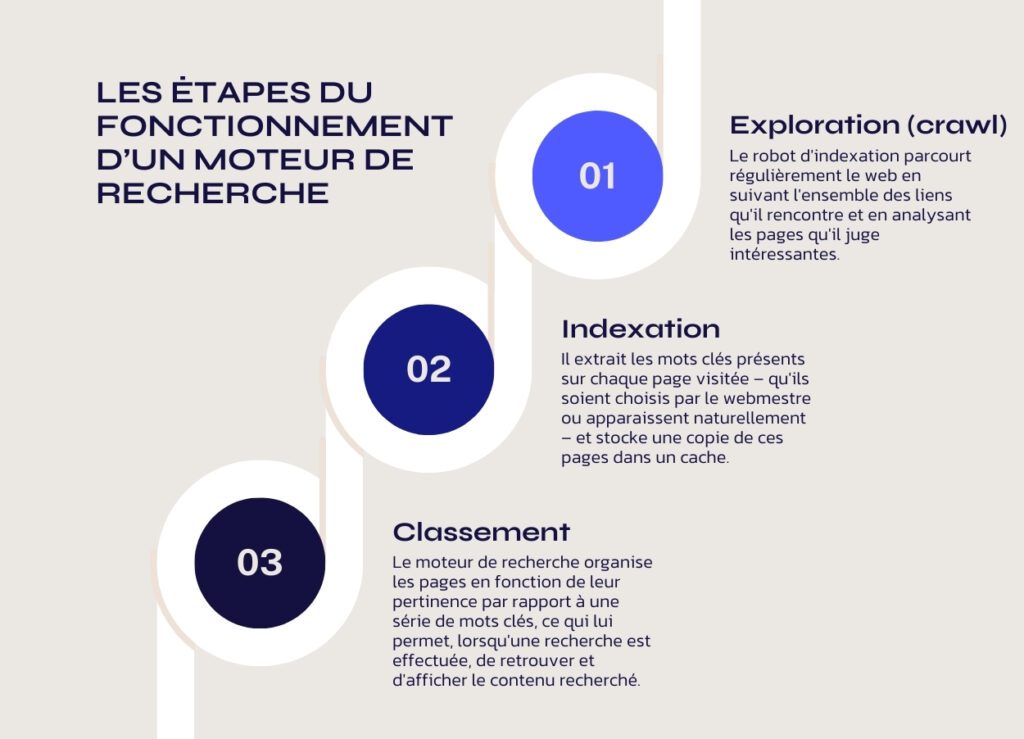The internet search engine plays an essential role in our daily lives. It allows us to quickly find relevant information by exploring the web and ranking millions of pages. In this article, we explain in detail how the search engine works, covering crawling, indexing, ranking, and SEO, while sharing essential SEO tips, particularly on the importance of backlinks.
At The Webix, we apply this approach to help our clients optimize their digital strategy. Indeed, we have found that a thorough understanding of how search engines work not only improves online visibility but also facilitates decision-making in digital marketing. We are confident that by mastering these techniques, you can transform your strategies and effectively boost your traffic.
This article breaks down the workings of internet search engines and offers practical advice to improve your online presence, providing you with essential keys to optimize your results and enhance your competitiveness in the digital world.
1. What is a search engine?
A search engine is an automated tool that crawls the web to collect data and index pages. As a result, users can find information thanks to this system, which relies on robots called crawlers. These crawlers continuously explore various sites, creating a searchable database in an instant. Thus, we often refer to the "search engine definition" as the tool that facilitates internet searching and provides quick access to various types of content. Ultimately, every query relies on this index to deliver relevant answers.
2. The crawling and indexing steps
Search engines operate in stages, each of which is crucial to obtaining precise results.
2.1 Crawling the web
First, crawlers move through the web, visiting sites and collecting their content. Each page is thoroughly scanned, and the robots follow both internal and external links to discover new pages. Furthermore, this continuous and automatic process allows the crawlers to update information and detect changes on sites. As a result, crawling ensures an up-to-date index.
2.2 Indexing pages
Once the content is collected, it is indexed in the search engine’s database. Each page is then tagged based on its content, with keywords and important expressions being identified – you often encounter examples like "search engine example" in concrete cases. Moreover, the information is organized by themes, enabling the search engine to instantly consult its index whenever a user performs a search, ensuring fast and relevant responses.
2.3 Ranking pages
Next, the search engine ranks the indexed pages using a complex and secret algorithm that evaluates the relevance of each page. This algorithm takes into account hundreds, even thousands, of factors to order the results. Among these criteria, we find, for example :
- Content quality : originality, length, semantic richness, etc.
- Site reputation : authority, number of incoming links, etc.
- Keyword proximity : the precise match between the content's keywords and the user's query.
- Site ergonomics : ease of use and overall user experience.
- Geographical location : adapting results based on the user's location.

3. Ranking algorithms and organic SEO
After indexing, search engines move on to ranking pages using complex algorithms.
3.1 Ranking criteria
On one hand, algorithms evaluate page relevance by considering factors like content quality, information freshness, and site structure. On the other hand, other elements, like incoming links, also influence ranking. As a result, the system assigns each page a score that determines its position in the results. Thus, users benefit from optimized rankings where each keyword, whether "search engine" or "the search engines," plays a role in the evaluation.
3.2 The importance of SEO in ranking
Moreover, organic SEO improves a site’s visibility by optimizing its content for search engines. Indeed, content that is rich in relevant information and well-optimized attracts better rankings. Additionally, incorporating keywords in titles, subtitles, and content is crucial, and using synonyms and related expressions – such as "online search" or "how it works" – further strengthens SEO. Therefore, a good SEO strategy helps appear among the top results, consequently increasing traffic and site credibility.
4. Different types of search engines and their specificities
There are various types of search engines, each with distinct objectives and features, allowing users to target their searches precisely.
4.1 All-in-one search engines
First, all-in-one search engines are the most widely used. For example, Google, Bing, and Yahoo! index the maximum number of web pages and provide results based on numerous criteria such as content relevance and site popularity. These tools offer a comprehensive search experience covering a wide range of topics.
4.2 Specialized search engines
Next, there are search engines that focus on specific niches. For example :
- Image search engines : Platforms like Google Images and Bing Images focus on searching and indexing visuals, allowing users to search for images by keywords or find similar images.
- Video search engines : YouTube, DailyMotion and other tools are dedicated to searching for video content, offering the possibility to filter by keywords, channels, or categories.
- Academic search engines : Services like Google Scholar and JSTOR focus on indexing research papers, scientific articles, theses, and books, catering to users seeking reliable academic sources.
- News search engines : Tools like Google News index news articles and blogs in real-time, allowing users to stay informed about specific topics.
- Vertical search engines : Some sites, while not traditionally search engines, serve this function by specializing in a particular domain, such as Amazon for product search, IMDb IMDb for movie information or Zillow for real estate.
Thus, these specialized engines complement the offerings of all-in-one engines and allow users to choose the most suitable tool for their specific needs.
5. Tips to optimize your SEO
To improve your ranking in search results, it is essential to master SEO and apply simple tips to optimize your content.
5.1 Choosing keywords
First, start by selecting the main keyword: "internet search engine." Then, add secondary keywords such as "search engine definition," "search engines," and "the search engines." Additionally, don’t forget to include complementary terms like "online search" and "how it works." These keywords should be naturally integrated into the text to enhance content relevance.
5.2 Content structuring
Next, divide the content into clear sections using headings and subheadings important for SEO. Each section should address a specific aspect, such as indexing, ranking, or SEO tips. Additionally, good structuring makes it easier to read and index by search engines, improving the user experience.
5.3 On-page optimization
Also, ensure that title tags and meta descriptions are well-crafted and include your main keywords. Furthermore, images should be optimized with relevant alt attributes, and the site’s loading speed should be fast. These technical adjustments enhance SEO performance and contribute to better ranking in search results.
5.4 The importance of backlinks
Finally, backlinks play a crucial role in SEO. They represent votes of confidence from other sites and enhance your content’s credibility. A quality backlink comes from an authoritative and relevant site, improving your ranking in search results. To obtain effective backlinks, start by creating rich and informative content, then collaborate with partners and consider guest blogging. As a result, each quality link helps increase your site’s authority, perfectly complementing on-page optimization.
6. The importance of trends and innovations in search engines
The search engine field is evolving rapidly, and technological innovations continuously influence how they work.
6.1 The impact of artificial intelligence
First, search engines are increasingly incorporating artificial intelligence to improve result relevance. Moreover, algorithms are becoming smarter and more adaptive, able to better understand the intent behind each search. Thus, AI enables more accurate ranking of pages, offering users an enriched experience.
6.2 Voice and mobile search
Additionally, voice search is growing rapidly, with voice assistants transforming how we search. Moreover, mobile optimization is crucial, as many users now browse from their smartphones. As a result, search engines are adapting their algorithms to accommodate these practices, requiring sites to comply with mobile requirements. Ultimately, an effective SEO strategy must integrate these trends to reach a larger and more diverse audience.
Towards better visibility on the web
Internet search engines are key to accessing information. Their operation relies on continuous crawling and meticulous indexing, while ranking algorithms assess the quality and relevance of pages. Meanwhile, a well-thought-out SEO strategy improves visibility and generates qualified traffic. To succeed online, it is essential to master optimization techniques by carefully selecting your keywords and structuring your content clearly. Additionally, adapt to innovations such as AI and mobile search to stay competitive in a constantly evolving digital environment. By adopting these tips and integrating an effective backlink strategy, you boost your online presence and attract targeted traffic while enhancing your site’s credibility.
At The Webix, our team of web and digital marketing specialists is at your disposal to help you optimize your SEO strategy and strengthen your online presence.
Feel free to contact our SEO agency in Longueuil at (450) 300-6119 or through our contact form..








